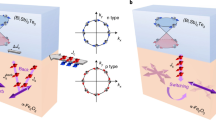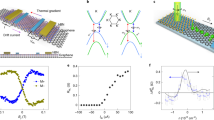Abstract
Van der Waals heterostructures with two-dimensional magnets offer a magnetic junction with an atomically sharp and clean interface. This attribute ensures that the magnetic layers maintain their intrinsic spin-polarized electronic states and spin-flipping scattering processes at a minimum level, a trait that can expand spintronic device functionalities. Here, using a van der Waals assembly of ferromagnetic Fe3GeTe2 with non-magnetic hexagonal boron nitride and WSe2 layers, we demonstrate electrically tunable, highly transparent spin injection and detection across the van der Waals interfaces. By varying an electrical bias, the net spin polarization of the injected carriers can be modulated and reversed in polarity, which leads to sign changes of the tunnelling magnetoresistance. We attribute the spin polarization reversals to sizable contributions from high-energy localized spin states in the metallic ferromagnet, so far inaccessible in conventional magnetic junctions. Such tunability of the spin-valve operations opens a promising route for the electronic control of next-generation low-dimensional spintronic device applications.
This is a preview of subscription content, access via your institution
Access options
Access Nature and 54 other Nature Portfolio journals
Get Nature+, our best-value online-access subscription
$29.99 / 30 days
cancel any time
Subscribe to this journal
Receive 12 print issues and online access
$259.00 per year
only $21.58 per issue
Buy this article
- Purchase on Springer Link
- Instant access to full article PDF
Prices may be subject to local taxes which are calculated during checkout




Similar content being viewed by others
Data availability
All data supporting the findings of this study are available from the corresponding authors on request.
References
Morosov, A. I. Ferromagnetic magnetization switching by an electric field: a review. Phys. Solid State 56, 865–872 (2014).
Dietl, T. A ten-year perspective on dilute magnetic semiconductors and oxides. Nat. Mater. 9, 965–974 (2010).
Heron, J. T. et al. Electric-field-induced magnetization reversal in a ferromagnet-multiferroic heterostructure. Phys. Rev. Lett. 107, 217202 (2011).
Gibertini, M., Koperski, M., Morpurgo, A. F. & Novoselov, K. S. Magnetic 2D materials and heterostructures. Nat. Nanotechnol. 14, 408–419 (2019).
Gong, C. & Zhang, X. Two-dimensional magnetic crystals and emergent heterostructure devices. Science 363, eaav4450 (2019).
Huang, B. et al. Emergent phenomena and proximity effects in 2D magnets and heterostructures. Nat. Mater. 19, 1276–1289 (2020).
Huang, B. et al. Electrical control of 2D magnetism in bilayer CrI3. Nat. Nanotechnol. 13, 544–548 (2018).
Jiang, S., Li, L., Wang, Z., Mak, K. F. & Shan, J. Controlling magnetism in 2D CrI3 by electrostatic doping. Nat. Nanotechnol. 13, 549–553 (2018).
Žutić, I., Fabian, J. & Sarma, S. D. Spintronics: fundamentals and applications. Rev. Mod. Phys. 76, 323–410 (2004).
Zhang, S., Levy, P. M., Marley, A. C. & Parkin, S. S. P. Quenching of magnetoresistance by hot electrons in magnetic tunnel junctions. Phys. Rev. Lett. 79, 3744–3747 (1997).
Jansen, R. & Moodera, J. S. Influence of barrier impurities on the magnetoresistance in ferromagnetic tunnel junctions. J. Appl. Phys. 83, 6682–6684 (1998).
Zhang, S. Spin Hall effect in the presence of spin diffusion. Phys. Rev. Lett. 85, 393–396 (2000).
Vera Marún, I. J., Postma, F. M., Lodder, J. C. & Jansen, R. Tunneling magnetoresistance with positive and negative sign in La0.67Sr0.33MnO3/SrTiO3/Co junctions. Phys. Rev. B 76, 064426 (2007).
Heiliger, C., Zahn, P., Yavorsky, B. Y. & Mertig, I. Influence of the interface structure on the bias dependence of tunneling magnetoresistance. Phys. Rev. B 72, 180406(R) (2005).
Yang, S., Zhang, T. & Jiang, C. Van der Waals magnets: material family, detection and modulation of magnetism, and perspective in spintronics. Adv. Sci. 8, 2002488 (2021).
Han, W., Maekawa, S. & Xie, X. C. Spin current as a probe of quantum materials. Nat. Mater. 19, 139–152 (2020).
Yuasa, S., Fukushima, A., Nagahama, T., Ando, K. & Suzuki, Y. High tunnel magnetoresistance at room temperature in fully epitaxial Fe/MgO/Fe tunnel junctions due to coherent spin-polarized tunneling. Jpn. J. Appl. Phys. 43, L588–L590 (2004).
Deiseroth, H. J., Aleksandrov, K., Reiner, C., Kienle, L. & Kremer, R. K. Fe3GeTe2 and Ni3GeTe2 – two new layered transition-metal compounds: crystal structures, HRTEM investigations, and magnetic and electrical properties. Eur. J. Inorg. Chem. 8, 1561–1567 (2006).
May, A. F., Calder, S., Cantoni, C., Cao, H. & McGuire, M. A. Magnetic structure and phase stability of the van der Waals bonded ferromagnet Fe3–xGeTe2. Phys. Rev. B 93, 014411 (2016).
Zhuang, H. L., Kent, P. R. C. & Hennig, R. G. Strong anisotropy and magnetostriction in the two-dimensional Stoner ferromagnet Fe3GeTe2. Phys. Rev. B 93, 134407 (2016).
Tan, C. et al. Hard magnetic properties in nanoflake van der Waals Fe3GeTe2. Nat. Commun. 9, 1554 (2018).
Liu, S. et al. Wafer-scale two-dimensional ferromagnetic Fe3GeTe2 thin films grown by molecular beam epitaxy. npj 2D Mater. Appl. 1, 30 (2017).
Fei, Z. et al. Two-dimensional itinerant ferromagnetism in atomically thin Fe3GeTe2. Nat. Mater. 17, 778–782 (2018).
Kim, K. et al. Large anomalous Hall current induced by topological nodal lines in a ferromagnetic van der Waals semimetal. Nat. Mater. 17, 794–799 (2018).
Seo, J. et al. Nearly room temperature ferromagnetism in a magnetic metal-rich van der Waals metal. Sci. Adv. 6, eaay8912 (2020).
Zhang, Y. et al. Emergence of Kondo lattice behavior in a van der Waals itinerant ferromagnet, Fe3GeTe2. Sci. Adv. 4, eaao6791 (2018).
Xu, X. et al. Signature for non-Stoner ferromagnetism in the van der Waals ferromagnet Fe3GeTe2. Phys. Rev. B 101, 201104(R) (2020).
Wang, Z. et al. Tunneling spin valves based on Fe3GeTe2/hBN/Fe3GeTe2 van der Waals heterostructures. Nano Lett. 18, 4303–4308 (2018).
Lin, H. et al. Spin-valve effect in Fe3GeTe2/MoS2/Fe3GeTe2 van der Waals heterostructures. ACS Appl. Mater. Interfaces 12, 43921–43926 (2020).
Nazir, G. et al. Ultimate limit in size and performance of WSe2 vertical diodes. Nat. Commun. 9, 5371 (2018).
Jang, S. W. et al. Origin of ferromagnetism and the effect of doping on Fe3GeTe2. Nanoscale 12, 13501–13506 (2020).
Li, X. et al. Spin-dependent transport in van der Waals magnetic tunnel junctions with Fe3GeTe2 electrodes. Nano Lett. 19, 5133–5139 (2019).
Tiusan, C. et al. Interfacial resonance state probed by spin-polarized tunneling in epitaxial Fe/MgO/Fe tunnel junctions. Phys. Rev. Lett. 93, 106602 (2004).
De Teresa, J. M. et al. Inverse tunnel magnetoresistance in Co/SrTiO3/La0.7Sr0.3MnO3: new ideas on spin-polarized tunneling. Phys. Rev. Lett. 82, 4288–4291 (1999).
Asshoff, P. U. et al. Magnetoresistance of vertical Co-graphene-NiFe junctions controlled by charge transfer and proximity-induced spin splitting in graphene. 2D Mater. 4, 031004 (2017).
Piquemal-Banci, M. et al. Insulator-to-metallic spin-filtering in 2D-magnetic tunnel junctions based on hexagonal boron nitride. ACS Nano 12, 4712–4718 (2018).
Gangineni, R. B. et al. Interfacial electronic transport phenomena in single crystalline Fe-MgO-Fe thin barrier junctions. Appl. Phys. Lett. 104, 182402 (2014).
Godel, F. et al. Voltage-controlled inversion of tunnel magnetoresistance in epitaxial nickel/graphene/MgO/cobalt junctions. Appl. Phys. Lett. 105, 152407 (2014).
Dorneles, L. S., Sommer, R. L. & Schelp, L. F. Tunnel magnetoresistance in NiFe/TaOx/Al2O3/Co junctions with a thin TaOx layer. J. Appl. Phys. 91, 7971–7973 (2002).
Tanaka, M. A. et al. Bias-voltage-dependence of magnetoresistance for epitaxial Fe/MgO/Co2MnSn tunnel junctions. J. Phys. Conf. Ser. 266, 012107 (2011).
Kalitsov, A. et al. Bias dependence of tunneling magnetoresistance in magnetic tunnel junctions with asymmetric barriers. J. Phys. Condens. Matter 25, 496005 (2013).
Chappert, C., Fert, A. & Van Dau, F. N. The emergence of spin electronics in data storage. Nat. Mater. 6, 813–823 (2007).
Dery, H., Dalal, P., Cywiński, Ł. & Sham, L. J. Spin-based logic in semiconductors for reconfigurable large-scale circuits. Nature 447, 573–576 (2007).
Quay, C. H. L., Chevallier, D., Bena, C. & Aprili, M. Spin imbalance and spin-charge separation in a mesoscopic superconductor. Nat. Phys. 9, 84–88 (2013).
Lin, M. W. et al. Ultrathin nanosheets of CrSiTe3: a semiconducting two-dimensional ferromagnetic material. J. Mater. Chem. C 4, 315–322 (2016).
Belianinov, A. et al. CuInP2S6 room temperature layered ferroelectric. Nano Lett. 15, 3808–3814 (2015).
Moodera, J. S., Miao, G. X. & Santos, T. S. Frontiers in spin-polarized tunneling. Phys. Today 63, 46–51 (2010).
Kim, S. et al. Highly efficient experimental approach to evaluate metal to 2D semiconductor interfaces in vertical diodes with asymmetric metal contacts. ACS Appl. Mater. Interfaces 13, 27705–27712 (2021).
Acknowledgements
K.-H.M., D.H.L., I.-H.L., D.H.H. and S.J. were supported by research grants for basic research funded by the Korea Research Institute of Standards and Science (no. KRISS-2020-GP20011059). J.E. and S.J. also acknowledge the support from the Basic Science Research Program through the National Research Foundation of Korea under grant nos NRF-2021R1A4A1031900 and NRF-2022R1A2C2008140. J.S. and J.S.K. were supported by the Institute for Basic Science through the Center for Artificial Low Dimensional Electronic Systems (IBS-R014-D1) and by the National Research Foundation of Korea (NRF-2022R1A2C3009731) and the Max Planck POSTECH/Korea Research Initiative (NRF-2022M3H4A1A04074153 and NRF-2020M3H4A2084417). S.-J.C. was also supported by the Würzburg-Dresden Cluster of Excellence on Complexity and Topology in Quantum Matter (EXC2147, project-id 390858490) and by the German Research Foundation (SPP1666 and SFB1170 ‘ToCoTronics’). C.K. acknowledges the support by the Institute for Basic Science in Korea (IBS-R009-G2).
Author information
Authors and Affiliations
Contributions
J.E., J.S.K. and S.J. conceived the experiments. K.-H.M. and D.H.L. fabricated the devices, conducted magneto-transport measurements and analysed the data. J.S. synthesized the FGT crystals under the supervision of J.S.K.; S.-J.C. established the theoretical model for vertical spin-dependent charge transport. I.-H.L., D.W.K. and J.H.S. performed electronic structure calculations and analyses. D.H.H. confirmed the WSe2 layer number with Raman and photoluminescence measurements, and K.-T.K. and C.K. performed the photoemission spectroscopy measurements on FGT crystals. K.W. and T.T. synthesized high-quality hBN crystals. K.-H.M., J.S.K., J.E. and S.J. cowrote the manuscript. All authors discussed the results and contributed to completing the manuscript.
Corresponding authors
Ethics declarations
Competing interests
The authors declare no competing interests.
Peer review
Peer review information
Nature Materials thanks Zhe Wang and the other, anonymous, reviewer(s) for their contribution to the peer review of this work.
Additional information
Publisher’s note Springer Nature remains neutral with regard to jurisdictional claims in published maps and institutional affiliations.
Supplementary information
Supplementary Information
Supplementary Figs. 1–8.
Rights and permissions
About this article
Cite this article
Min, KH., Lee, D.H., Choi, SJ. et al. Tunable spin injection and detection across a van der Waals interface. Nat. Mater. 21, 1144–1149 (2022). https://doi.org/10.1038/s41563-022-01320-3
Received:
Accepted:
Published:
Issue Date:
DOI: https://doi.org/10.1038/s41563-022-01320-3
This article is cited by
-
Two-dimensional magnetic materials for spintronic applications
Nano Research (2024)
-
Large and tunable magnetoresistance in van der Waals ferromagnet/semiconductor junctions
Nature Communications (2023)



